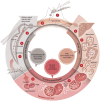Overview of Plasmodium spp. and Animal Models in Malaria Research
- PMID: 38902006
- PMCID: PMC11373680
- DOI: 10.30802/AALAS-CM-24-000019
Overview of Plasmodium spp. and Animal Models in Malaria Research
Abstract
Malaria is a parasitic disease caused by protozoan species of the genus Plasmodium and transmitted by female mosquitos of the genus Anopheles and other Culicidae. Most of the parasites of the genus Plasmodium are highly species specific with more than 200 species described affecting different species of mammals, birds, and reptiles. Plasmodium species strictly affecting humans are P. falciparum, P. vivax, P. ovale, and P. malariae. More recently, P. knowlesi and other nonhuman primate plasmodia were found to naturally infect humans. Currently, malaria occurs mostly in poor tropical and subtropical areas of the world, and in many of these countries it is the leading cause of illness and death. For more than 100 y, animal models, have played a major role in our understanding of malaria biology. Avian Plasmodium species were the first to be used as models to study human malaria. Malaria parasite biology and immunity were first studied using mainly P. gallinaceum and P. relictum. Rodent malarias, particularly P. berghei and P. yoelii, have been used extensively as models to study malaria in mammals. Several species of Plasmodium from nonhuman primates have been used as surrogate models to study human malaria immunology, pathogenesis, candidate vaccines, and treatments. Plasmodium cynomolgi, P. simiovale, and P. fieldi are important models for studying malaria produced by P. vivax and P. ovale, while P. coatneyi is used as a model for study- ing severe malaria. Other nonhuman primate malarias used in research are P. fragile, P. inui, P. knowlesi, P. simium, and P. brasilianum. Very few nonhuman primate species can develop an infection with human malarias. Macaques in general are resistant to infection with P. falciparum, P. vivax, P. malariae, and P. ovale. Only apes and a few species of New World monkeys can support infection with human malarias. Herein we review the most common, and some less common, avian, reptile, and mammal plasmodia species used as models to study human malaria.
Conflict of interest statement
The authors have no conflicts of interest to declare.
Figures

Similar articles
-
Phylogeny of Asian primate malaria parasites inferred from apicoplast genome-encoded genes with special emphasis on the positions of Plasmodium vivax and P. fragile.Gene. 2010 Jan 15;450(1-2):32-8. doi: 10.1016/j.gene.2009.10.001. Gene. 2010. PMID: 19818838
-
Malaria parasites in macaques in Thailand: stump-tailed macaques (Macaca arctoides) are new natural hosts for Plasmodium knowlesi, Plasmodium inui, Plasmodium coatneyi and Plasmodium fieldi.Malar J. 2020 Oct 1;19(1):350. doi: 10.1186/s12936-020-03424-0. Malar J. 2020. PMID: 33004070 Free PMC article.
-
Zoonotic malaria - global overview and research and policy needs.Front Public Health. 2014 Aug 18;2:123. doi: 10.3389/fpubh.2014.00123. eCollection 2014. Front Public Health. 2014. PMID: 25184118 Free PMC article. Review.
-
Systems biology of malaria explored with nonhuman primates.Malar J. 2022 Jun 7;21(1):177. doi: 10.1186/s12936-022-04199-2. Malar J. 2022. PMID: 35672852 Free PMC article. Review.
-
Natural vectors of Plasmodium knowlesi and other primate, avian and ungulate malaria parasites in Narathiwat Province, Southern Thailand.Sci Rep. 2023 Jun 1;13(1):8875. doi: 10.1038/s41598-023-36017-3. Sci Rep. 2023. PMID: 37264067 Free PMC article.
Cited by
-
Plasmodium yoelii as a model for malaria: insights into pathogenesis, drug resistance, and vaccine development.Mol Biol Rep. 2025 Feb 5;52(1):208. doi: 10.1007/s11033-025-10318-4. Mol Biol Rep. 2025. PMID: 39907835 Free PMC article. Review.
-
Animal Models of Malaria-Associated Acute Kidney Injury.Semin Nephrol. 2025 May;45(3):151616. doi: 10.1016/j.semnephrol.2025.151616. Epub 2025 May 15. Semin Nephrol. 2025. PMID: 40374463 Review.
-
Evaluating the Antiplasmodial Activity of Picrasma javanica Stem Bark Extract and Its Synergy With Artesunate in Rodent Malaria Models.Scientifica (Cairo). 2025 Jun 4;2025:7344444. doi: 10.1155/sci5/7344444. eCollection 2025. Scientifica (Cairo). 2025. PMID: 40501454 Free PMC article.
References
-
- Aikawa M, Brown AE, Smith CD, Tegoshi T, Howard RJ, Hasler TH, Ito Y, Collins WE, Webster HK. 1992Plasmodium coatneyi-infected rhesus monkeys: A primate model for human cerebral malaria Mem Inst Oswaldo Cruz 87Suppl 3443–447 - PubMed
-
- Alavi Y, Arai M, Mendoza J, Tufet-Bayona M, Sinha R, Fowler K, Billker O, et al. 2003The dynamics of interactions between Plasmodium and the mosquito: A study of the infectivity of Plasmodium berghei and Plasmodium gallinaceum, and their transmission by Anopheles stephensi, Anopheles gambiae and Aedes aegypti Int J Parasitol 33933–943 - PubMed
-
- Allison AC. 2009Genetic control of resistance to human malaria Curr Opin Immunol 21499–505 - PubMed
Publication types
MeSH terms
LinkOut - more resources
Full Text Sources
Medical
Miscellaneous

